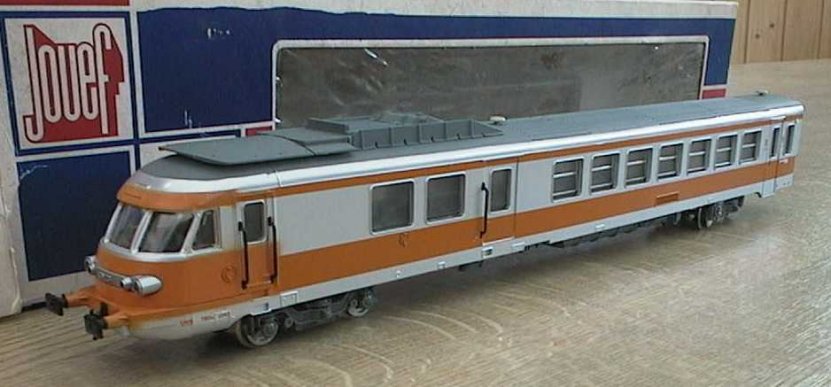

8611 - the SNCF gas turbine railcar (RTG) driving vehicle
Prototype information
| Conceived just after the
delivery of the last ETG , the Gas Turbine Trains (Rames Turbine a Gaz - RTG)
were the second generation of turbotrains delivered to the SNCF. Among the
innovations, was a second power car thus doubling the power of the trains.
The sets were lengthened with the addition of an extra trailer, which made
them up to five cars thus offering additional capacity. These trains worked
from the beginning in multiple and were gradually converted to work in
multiple with the ETG's. One coach was all first and to improve comfort, the
seats are spaced at 2 + 1. The other innovation was air-conditioning which
improved the comfort of these trains considerably during the 1970's. The
first sets delivered in 1973 were sent to work the Lyon-Strasbourg,
Lyon-Nantes or Lyon-Bordeaux routes. The following ones having a higher
seating capacity were delivered in 1975 to replace the ETG's which did not
have sufficient seats on the Paris-Caen-Cherbourg route. From 1978 to 1981,
their composition was altered to six coaches to increase their capacity
significantly, but this experiment had no future since the platforms at
Paris St-Lazare were not sufficiently long to take the new trains in
multiple. After the oil crises of 1973 and 1979, the SNCF decided to equip
one set with a new turbine Turmo XII Turboméca which was much more powerful
and promised a saving in energy. The design and interior idecor of these
machines quickly aged and the electrification of Lyon-Strasbourg in 1995 and
Paris-Caen-Cherbourg in 1996 and the arrival of the BB16000's and 26000's
prompted an increase in the rate of their withdrawal from SNCF.
Ten smaller trains were still available and maintained with Vénissieux depot to ensure their continued existence on the cross-country line between Lyon and Bordeaux, no alternative trains being available. Six of the remaining trains will probably be re-furbished internally for service. As for T2077 and 2081, they were converted into the RTG High Speed Tilting train (HVP) called Axis. The conversion took place at ANF in Crespin in 1997 and the first tilting tests undertaken by Bombardier Transport on the line took place in 1998. |
| Type | Turbotrain TBDu 2038 |
Pictured at Caen 17th September 1977 |
|
No: Built : |
82 | |
|
Operating area : |
Eastern region | |
|
Number range: |
T 2001 to 2082 | |
|
Power: |
2060 kw. | |
|
Maximum speed: |
160 km/h | |
|
Weight: |
62 tons (train 225 t.) | |
| Total train length | 130 m | |
|
Manufacturer: |
ANF Crespin | |
|
Date entered service: |
1973 to 1976 |